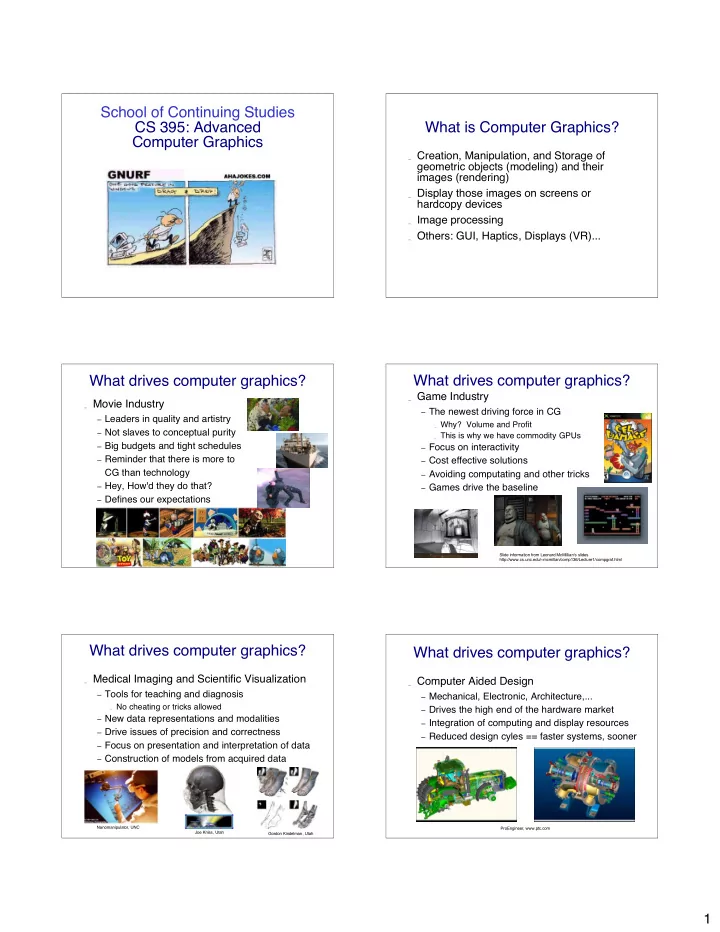

School of Continuing Studies CS 395: Advanced What is Computer Graphics? Computer Graphics _ Creation, Manipulation, and Storage of geometric objects (modeling) and their images (rendering) _ Display those images on screens or hardcopy devices CS 351 _ Image processing _ Others: GUI, Haptics, Displays (VR)... What drives computer graphics? What drives computer graphics? _ Game Industry _ Movie Industry – The newest driving force in CG – Leaders in quality and artistry _ Why? Volume and Profit – Not slaves to conceptual purity _ This is why we have commodity GPUs – Big budgets and tight schedules – Focus on interactivity – Reminder that there is more to – Cost effective solutions CG than technology – Avoiding computating and other tricks – Hey, How'd they do that? – Games drive the baseline – Defines our expectations Slide information from Leonard McMillian's slides Slide information from Leonard McMillian's slides http://www.cs.unc.edu/~mcmillan/comp136/Lecture1/compgraf.html http://www.cs.unc.edu/~mcmillan/comp136/Lecture1/compgraf.html What drives computer graphics? What drives computer graphics? _ Medical Imaging and Scientific Visualization _ Computer Aided Design – Tools for teaching and diagnosis – Mechanical, Electronic, Architecture,... _ No cheating or tricks allowed – Drives the high end of the hardware market – New data representations and modalities – Integration of computing and display resources – Drive issues of precision and correctness – Reduced design cyles == faster systems, sooner – Focus on presentation and interpretation of data – Construction of models from acquired data Nanomanipulator, UNC ProEngineer, www.ptc.com Joe Kniss, Utah Gordon Kindelman, Utah 1
What drives computer graphics? What is Computer Graphics? _ Rendering _ Graphic User Interfaces (GUI) – Photorealistic – www.webpagesthatsuck.com – Non-Photorealistic – Image-based techniques – Texture Synthesis _ Modeling _ Interaction: Perception and Virtual Environments _ Hardware Rendering _ Animation _ Simulation and Dynamics Slide information from Leonard McMillian's slides http://www.cs.unc.edu/~mcmillan/comp136/Lecture1/compgraf.html Slide information from Richard Riesenfeld Rendering Rendering _ Many think/thought graphics synonymous _ Major areas: with rendering – Ealiest: PhotoRealism _ Well researched – Recent: Non-Photorealistic Graphics (NPR) – Working on second and third order effects – Recent: Image-based Rendering (IBR) – Fundamentals largely in place Rendering Realism Rendering _ Ray Tracing has become practical – Extremely high quality images – Photorealism, animation, special effects _ Accurate rendering, not just pretty Evening Morning a preetham, et. 2
Rendering Realism Rendering Realism Synthetic Real Cornel Measurement Lab Shirley, et. al., cornell Terrain Modeling: Is this real? Snow and Trees Added s premoze, et.al., utah m fajaro, usc Growth Models Rendering/Modeling Hair o deusson, /Users/gooch/Desktop/tabby.qt.moov http://www.rhythm.com/~ivan/hairRender.html 3
Humans Scientific Visualization National Library of Medicine Johnson et al., Utah Final Fantasy (Sony) Jensen et al. Visual Human Is Photorealism Everything? Is Photorealism Everything? Tone Shading Non-Photorealistic Rendering b gooch, et.al., utah a gooch, et. al., utah 4
NonPhotorealistic Rendering Image Based Rendering _ Model light field _ Do not have to model geometry _ Good for complex 3D scenes _ Can leave holes where no data is available 3D Scene Capture 3D Scene Recreation Fuchs et.al., UNC Faugeras et. al UNC and UVA 360 o Scan Modeling _ Many model reps – Bezier, B-spline, box splines, simplex splines, polyhedral splines, quadrics, super-quadrics, implicit, parametric, subdivision, fractal, level sets, etc (not to mention polygonal) p willemsen, et. al., utah 5
Modeling Modeling... is hard _ Physically based _ Complexity – Newton _ Shape – Behavior as well as geometry _ Specifying _ Materials _ Realistic constraints – Metal, cloth, organic forms, fluids, etc _ Detail vs concept _ Procedural (growth) models _ Tedious, slow s drake, et. al., utah Modeling is hard Growth Models _ Mathematical challenge _ Computational challenge _ Interaction challenge _ Display challenge (want 3D) _ Domain knowledge, constraints o deusson, Model Capture Models D Johnson and J D St Germain, Utah marc levoy, et. al., stanford Russ Fish et al., Utah 6
Interaction Interaction still needs... _ Way behind rest of graphic's spectacular _ Better input devices advances _ Better output devices _ Still doing WIMP: _ Better interaction paradigms – Windows, icons, menus, pull-downs/pointing _ Better understanding of HCI _ Once viewed as “soft” research – Bring in psychologists – Turns out to be one of hardest problems Hardware: Amazing Changes Hardware: Amazing Changes _ Fundamental architecture shift _ Fast, cheap GPUs – Dual computing engines: – ~$300 _ CPU and GPU _ Cheap memory _ More in GPU than CPU _ Displays at low cost – How many monitors do you have/use? Hardware: Amazing Changes Hardware... some not so good _ Wired -> Unwired _ Devices _ World of Access _ 3D displays _ Etc 7
Hardware In This Class _ How old is Nvidia _ We will read lots of papers _ How big is Nvidia _ Most important is reading papers _ QED – State what you found to be the most interesting – What you were confused about or would like to understand better _ Presentations Np Required Books Each class _ Introduction Lecture by me _ At least 2 paper reviews led by student _ Occasional Animation viewing _ Project discussion and help session _ At least one 15 minute break in the middle Grades _ 15 % = Class participation _ 35 % = Presentations _ 50 % = Project 8
Recommend
More recommend